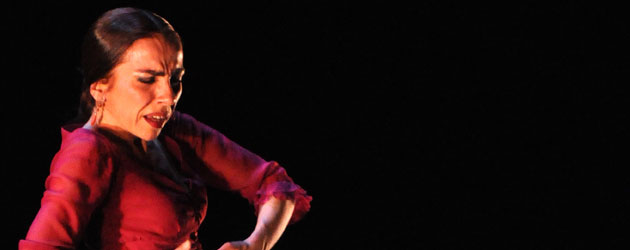Text: Estela Zatania
Photos: Ana Palma
Wednesday, February 27th, 2013. Jerez de la Frontera
Special 17th Festival de Jerez – All the information
THREE TAKES ON NO-FRILLS FLAMENCO
ISABEL BAYÓN “CAPRICHOS DEL TIEMPO”
Teatro Villamarta, 9:00pm
Seville dancer Isabel Bayón presented her work “Caprichos del Tiempo” on Wednesday night at the Villamarta Theater. She made the most of her clean approach to represent a complex libretto about the eternal cycle of modern and antique, and the process by which both conditions come about and are perceived.

In this respect, the most eloquent image was to be found on the front of the program where we see Isabel looking at herself in the mirror, adjusting the same kind of cap people from the mountains used to wear in Spain, and which the dancer wore at twelve years old to dance rondeña. Three decades later, she continues to maintain the same artistic persona, a concept based on control, emotion withheld and the beauty of form.

It’s quite a marathon of dance for Isabel who barely rests during the almost 90-minute show, backed up the by guitars of Jesús Torres and Juan Requena, the singing of David Lagos and Londro and the percussion of José Carrasco.
RANCAPINO CHICO
Ciclo: Los conciertos de palacio
Palacio Villavicencio, 7:00pm
Known artistically as Rancapino Chico, this young singer is the great-grandson of la Obispa, nephew of Orillo del Puerto and of course, son of Alonso Núñez Núñez “Rancapino”, one of the most beloved veterans of flamenco singing. Having cleared up the irreproachable ancestry, let’s talk about his performance last night in the charming venue of the Palacio Villavicencio.
The young man began with soleá, very much in the line of his illustrious father, and with the audience rooting for him every step of the way; there was the logical desire to see a continuation of the admirable family line. That responsibility must have weighed heavily, because he appeared more nervous than last summer at the Viernes Flamenco when he handily won over a multitudinous audience in the large open courtyard.
He was more together for alegrías, and then went on to interpret some Camarón tangos, the legendary “Rosa María” and other songs of Turronero and Marelu composed by Paco Cepero, a nostaligic trip back to the nineteen-seventies and eighties which this young man had to have absorbed through his father. Free-form fandangos and Huelva followed by bulerías…a limited repertoire that did not keep the audience from rewarding the singer with an enthusiastic ovation.
A very special mention for el Niño de Periquín, Jerito, for his sensitivity and respect as accompanist; he didn’t take his admiring gaze off the singer even during falsetas!
Rancapino senior who was sitting next to me let out the occasional “¡olé, bien!”, and his face was a portrait of fatherly pride.
ÁNGELES GABALDÓN “CON CORRIENTE”
Series: Muy flamencos
Sala Compañía, 12 midnight
It takes bravery to do something unheard of, to stand out from the crowd and unambiguously declare your intentions and objectives. And not only bravery, but the ability and intelligence to make good on it.
Or perhaps it’s just that what they teach all budding writers, to write about what they know best, can also be applied to dance. Because Ángeles Gabaldón received the most academic sort of dance preparation. Hard worker that she is, she has already presented various works of medium and large format. In those earlier projects, carried out in times of abundance, the dancer allowed herself to experiment, each work more avant-garde than the previous one, because it was also the best way to attract public subsidies which have now dried up for all practical purposes.
In the year 2013 there’s no more money around. Not only artists, but all of us have to make do with what we have at hand, and what Ángeles Gabaldón has at hand is good taste and knowledge acquired through many years of experience. This time she came to the Festival de Jerez with a bare-bones show. Rather than seek the false simplicity of an empty darkened stage without voice or guitar, she reveled in the “complicated” simplicity of cante, guitar and compás to frame her dances. No cajón, no percussion, no instrumentation or props…not even a libretto more complex than the expressed desire to recuperate accessories and forms that have been neglected over the years.
Most admirable was that she managed to get into that aesthetic without it being a “tribute”, without re-creating anything. It was all here and now. The garrotín with Cordovan hat, siguiriyas with bata de cola and castanets, guajira with old-style singing, a large fan and an elegant dress sprinkled with discreet sequins, alegrías (there were four full-length dances) with white bata de cola and salmon-colored shawl; that makes two days in a row with color on stage, perhaps this is the beginning of the end of the “all-black” fad.
The two singers, David Lagos and Londro, who appeared less than two hours earlier at the Villamarta with Isabel Bayón, were as good singing for the dance as in the a capella interlude with an especially beautiful interpretation of the pregón of el Niño de las Moras by David.
And that guitar! It could be none other than Rafael Rodríguez “El Cabeza”. Nearly the only one nowadays not infected with the “J virus”…there are no jazz harmonies in his playing, and yet the music sounds current and dynamic, full of energy and personality.
A fresh crispy show that reflects current trends through classic forms. The use of accessories that had gone out of style, or nearly obsolete cantes, does not date this work at all. In fact, Ángeles Gabaldón obliges us to admit that the only thing that is never in style is bad taste.
